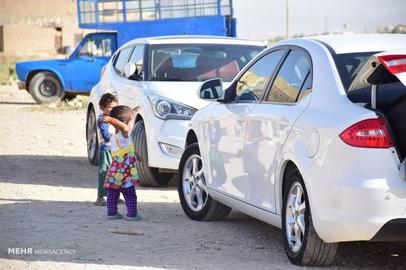What is the magnitude of poverty in Iran? It’s an important question, but until now there have been no reliable and comprehensive statistics to allow for adequately objective answers beyond conjecture and anecdotes. But in early December 2018, the Iranian parliament’s Research Center published a pioneering and comprehensive report on absolute poverty in the 31 provinces of Iran [Persian link] for the Iranian calendar year of 1395 (March 20, 2016-March 20, 2017).
The figures give considerable cause for concern.
Absolute Poverty
Objective answers for the rate of poverty, however, need measurable criteria. What is poverty or, to be more exact, “absolute” or “extreme” poverty? A report published by the United Nations in 1995 described it as follows: “Absolute poverty is a condition characterized by severe deprivation of basic human needs, including food, safe drinking water, sanitation facilities, health, shelter, education and information. It depends not only on income but also on access to social services.”
The World Bank has set a more quantitative standard. It defines the poverty line at a daily income of $1.9 in 2010 prices, which translated to over $2 in 2016 prices, or more than $600 per month. In 2016, one US dollar was worth 3,500 Iranian tomans, so the poverty line in Iran stood around 2.1 million tomans per month. This figure must be adjusted for its purchasing power in various countries around the world and various localities within a specific country.
The first report in this series introduced the concepts, the methods and the statistical foundations used to arrive at a general picture of poverty in Iran at the national level. In this article, we explore poverty in the province of Qom, often referred to as the “religious capital of Iran.”
Poverty and Margin-Dwelling in the Religious Capital of Iran
Qom covers less than one percent of the total land area of Iran, its population is 1.6 percent of the country’s total population and it is not split up into multiple counties. In fact, until 1995, Qom was actually a county in Tehran province. At that time, the Supreme Leader Ayatollah Khamenei exhorted the parliament to turn Qom into a province in its own right. There was only one reason: The city of Qom is home to the largest seminary in Iran and is considered to be the power base of the Shia clergy.
Qom is also the third poorest province in Iran. According to data provided by the parliament’s Research Center, around 37 percent of Qom’s population, or about 476,000 of the province’s inhabitants, live below the absolute poverty line.
One important characteristic of Qom is that the absolute majority of its population live in urban areas. It has the lowest rural population in Iran, 62,000, and the highest rate of urban dwelling, over 95 percent. The high rate of poverty is especially jarring if it is contrasted with the outsize influence of Qom’s religious authorities on political, religious and even, sometimes, economic affairs of Iran.
Urban Poverty
In 2016, 38 percent of Qom’s urban population, or close to 468,000, lived below the poverty line. The average number of people in an urban household is 4.2 and in 2016 each household needed a monthly income of more than 1,365,047 ($326) to stay above the poverty line. The poverty line for an individual in the same year was 505,573 tomans ($121). After Tehran, Qom is among the provinces with the highest rural and urban poverty lines in Iran.
To update these numbers, we referred to the available statistics for inflation for each province. According to the data provided by the Statistical Center of Iran, the prices in Qom in November 2018 show an increase of close to 40 percent compared with prices in 2016 [Persian PDF]. By taking this rate into account, we arrive at the updated poverty line in the urban areas of the province adjusted for inflation: 705,780 tomans ($169) per person and 1,905,606 tomans ($455) for a household. The latter number is higher than the minimum monthly salary in 2018 [Persian link], meaning that many workers in Qom’s urban areas who work for minimum wage are either below the poverty line or very close to it.
According to the latest available job numbers, Qom has one of the lowest unemployment rates in Iran: 10.9 percent compared to the national average of 12.1 percent [Persian PDF]. Nevertheless, the labor force participation rate — the sum of all employed workers divided by the working-age population — in Qom is very low.
Rural Poverty
The small rural population of Qom consists of 18,196 households with an average size of 3.9 people each. Of these, more than 2,200 households live under the poverty line. Of the rural population of Qom, close to 14 percent live under the poverty line, less than half of the same rate in urban areas of the province. Nevertheless, this lower rate is somewhat misleading and does not mean that people living in villages encounter better conditions. On the contrary, the inhospitable economic conditions in the countryside have been constantly forcing villagers to migrate to the cities where most of them end up living on the margins.
In 2016, the absolute rural poverty line in Qom was 432,314 tomans ($104) for one person and 1,167,248 tomans ($279) for an average household of 3.9 people, according to the parliament’s Research Center. If the numbers are adjusted for inflation in the province, they would be around 40 percent higher in November 2018 than they were in 2016: 603,943 tomans ($144) for one person and 1,630,645 tomans ($390) for a household.
These numbers are not significantly different from the corresponding figures for urban Qom.
Read the full Poverty in Iran series:
Poverty in Iran: An Introduction
Poverty in Iran: West Azerbaijan
Poverty in Iran: Sistan and Baluchistan
Related Coverage:
Revealed: Absolute Poverty in Iran, December 7, 2018
Could a 20% Salary Increase Help State Employees?, December 5, 2018
Iran Rushing Toward 30 Percent Inflation, November 27, 2018
, October 30, 2018
Runaway Inflation and the Nationwide Trucker Strike, October 4, 2018
Families and Fishermen Lose Out as Prices Rise, October 1, 2018
visit the accountability section
In this section of Iran Wire, you can contact the officials and launch your campaign for various problems

























comments